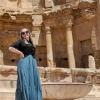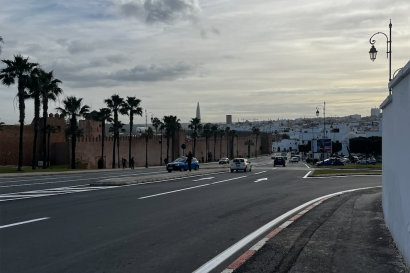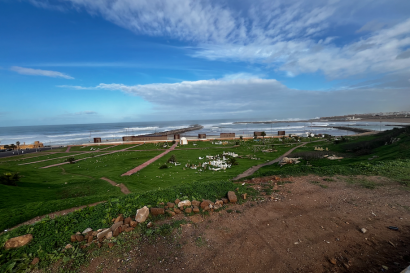Throughout the last two months, I have discovered many things I love about Morocco. In particular, I have absolutely fallen in love with the unique and intricate beauty of Islamic architecture, a style I had previously believed was only genuinely prevalent in the Middle East and North Africa. So, imagine my delight when I traveled to Spain with my cohort and discovered an entire assortment of Islamic architectural monuments throughout this neighboring European country!
However, before I unveil the wondrous intersection of Islamic and European history in Spain, I’d like to take you on a journey through my tour of Islamic architecture in Morocco.
Morocco, an Ocean of Islamic History:
My expedition into the world of art and architecture started relatively early into my program. In fact, my first weekend in Morocco was spent in the sprawling city of Fez, in which I was able to gaze upon two rather magnificent displays of Islamic art and architecture.
First off, one of our first stops on our tour of this beautiful city was to visit the majestic gates of the Royal Palace in Fez. With arched doors covered in gold, covered in geometric carvings, and bordered by intricate mosaics of blue, white, and green, these seven gates stand as a wonderful tribute to Islamic artistic and architectural tradition. You could hardly deny that they belonged to a palace, with their illustrious grandeur that created an exquisite introduction to the city. I could have stared at it for hours had we not needed to continue on with the tour.
From the palace gates, we made our way into the maze-like Old Medina of Fez. Surrounded by vendors shouting prices and conversing with customers, as well as piles upon piles of various goods, I was initially incredibly overwhelmed. All that existed was chaos, and I could barely think in the midst of everything that was going on. Then, we stepped through the doors to the Al-Attarine Madrasa, and it was as if we had entered a man-made oasis of peace. The tiled floor surrounding a floral fountain made of marble, the high arches covered in mosaics and carved calligraphy of Qu’ranic verses, and the open ceiling created a wide open space in which you could breathe and be one with a spiritual beauty that permeated every aspect of the space. To this day, it is one of my favorite testaments to Islamic architecture. However, in my opinion, the Al-Attarine Madrasa’s beauty was easily surpassed by the beautiful behemoth of the Hassan 2nd Mosque in Casablanca.
Located on the coastline, this mosque stands as one of the largest and arguably one of the most beautiful mosques in the world. I was lucky enough to be able to take a tour through the mosque, and as soon as I entered the mosque it was as if my breath had been pulled from my chest at the sight of the opulent beauty in front of me. Geometric and calligraphic motifs made from ceramic tile and wood surrounded me in a lavish display of Islamic religious, artistic, and architectural traditions that I could hardly comprehend what I was looking at. It was such a change from other religious sites I had visited such as the Vatican City, and yet I believe this mosque more than exceeded the display of elegance with its detailed, non-figurative artistry.
After visiting these wondrous displays of Islamic art and architecture, I believed I would need to venture further into Morocco to explore any other similar sites. However, I had forgotten about our planned visit to Spain, and in turn the new dimension of Islamic architecture I would be exposed to.
Spain, The Fruit of a Beautiful Blend of Cultures:
During our time in Spain, I visited two cities of particular historical importance to Spain’s time as part of Islamic rule: Córdoba and Granada. It was in these two cities that I explored the blend of Islamic and Catholic architectural traditions, particularly in the Medinat al Zahra and Mosque of Córdoba in the city of Córdoba and the Alhambra in Granada.
Within the Medinat al Zahra, I was exposed to more imagery based on nature, such as stylized patterns of flowers and trees carved into plaster that adorned the arches of the medieval Islamic city. These designs embraced the idea of paradise in their pairing with large open courtyards in which fountains and pools once brought forth water to transform the designs into an architectural garden. As I stood in this space, I could still see its grandeur and intricacy despite it being long since abandoned after its conquest.
Then, after perusing the medieval ruins of the Medinat al Zahra, we made our way to the center of Córdoba where the Mosque of Córdoba, now a Catholic cathedral, stood in all its glory. Within its walls, I delighted in the mix of architectural motifs from gothic cathedrals and those of mosques, and as I moved through the space, it truly felt as if I were watching a conversation between Catholic and Islamic traditions and history. The calligraphic and floral motifs that remained from the mosque created a stunning contrast with painted biblical scenes and statues of angels and the Virgin Mary. The traditional red and white arches of the mosque popped against the pristine, intricate white arches of the cathedral. All in all, it was a dialogue of Spain’s religious history, one that I could see playing out in real-time.
This same religious and cultural exchange also showed itself during our visit to the Alhambra, a beautiful palace in the former Islamic city of Granada. The beautiful zellige tiles that make up the geometric patterns of Islamic architecture were on full display in their museum, while the traditional arches and carved calligraphy made up many of the entrances to the Alhambra itself. Then, in the Palace of Charles V, Greco-Roman pillars and carvings of trumpeting angels showed off the Catholic influences on this palace’s architecture. Just like the Mosque of Córdoba, I was witness to a long-standing exchange between the Islamic empires of the Middle East and North Africa, and the Catholic kings and queens of Spain through a stunning blend of artistic and architectural traditions.
Now, as I reflect on these parallels, I have to say that I don’t think anything represents Spain and its history better than these monuments and the reflection of the past they create. Every country, its people, and its cultures are shaped by interactions like these, in which there is an exchange between peoples and cultures and all of their different characteristics. As an anthropologist, I have always known and understood this to be true. However, nothing compares to seeing this dialogue play out in person.
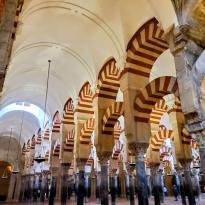







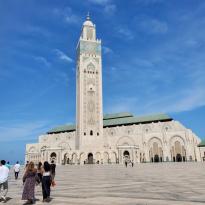
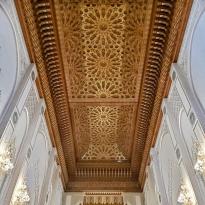

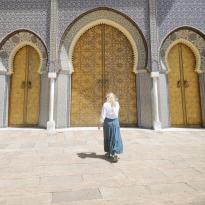
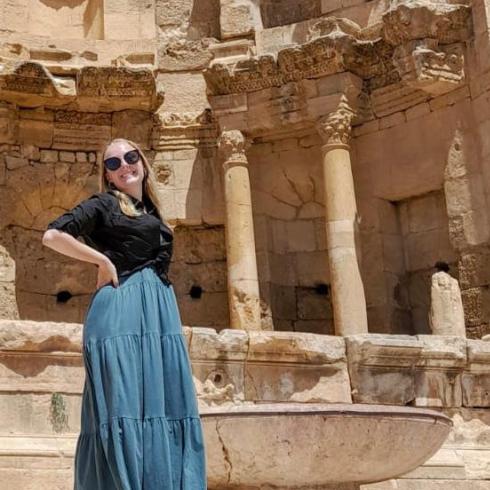
Kiki Giles
A rising junior hailing from the College of Wooster, I'm pursuing a double major in Anthropology and French/Francophone Studies with an accompanying double minor in MENA Studies and Statistical/Data Sciences. These intersecting fields brought me to my upcoming study abroad experience in Morocco, where I am incredibly excited to explore the many cultures and languages that have shaped this beautiful country. Other interests of mine include international baking, travel, and music.














